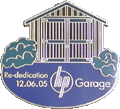

My two American friends, Kenneth Kuhn and Glenn Robb, met together this month for a complete tour of the most significant locations to the Hewlett Packard Company's origin in the Silicon Valley. Both collectors are enthusiasts of the HP story. Art Fong and John Minck were their hosts during this trip and they had the opportunity to tour some of the important locations to the HP story.
This little walk down memory lane helps take us back to a time when HP was Silicon Valley's prime example of what a technology powerhouse could and should look like.
 |
The recently restored Addison Avenue House and Garage Courtesy of Hewlett Packard Company |
The Garage, 367 Addison Avenue,
Palo Alto
About 2000, when the 367 house came on the commercial market, HP made the decision to purchase it for posterity. With Palo Alto real estate prices soaring into the clouds, the purchase price was hundreds of times more than its value in the mid-1930s when Dave and Lucile Packard rented the first floor.
Over the last several years, HP in an effort to preserve for future generations its most famous piece of real estate, recently completed the restoration of the house and original garage. The completed house inside was excellent, even the finding of a vintage kitchen oven from the period when Dave and Bill used Lucile's oven to bake the panel paint of their products.
A complete report of this wonderful work of memory can be seen on the History Link of the HP Web Site.
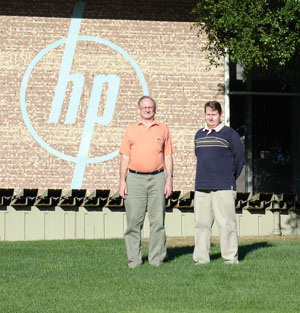 |
Kenneth Kuhn (left) and Glenn Robb Standing ahead of the original company logo |
Page Mill Road
The Page Mill industrial site on Stanford University land could be considered the third important location in HP history.
The second important location for HP history was the complex of buildings on the Page Mill Road block that included the 195 to 395 Page Mill addresses.
Having outgrown the garage, in 1940 Hewlett-Packard moved to a rented building at 481 Page Mill Road, the “Tinkerbell” building and then for WWII expansion moved one block to the newly-constructed “Redwood” building at 395 Page Mill Road.
The Stanford industrial park complex opened in 1958, expanded to 6 major buildings, and is still in use today. After sixty years of evolution this building houses the legendary HP Laboratories at 1501 Page Mill Road. These buildings featured beautiful mosaic decorations on the side walls, which include the original rhomboid logo of the company.
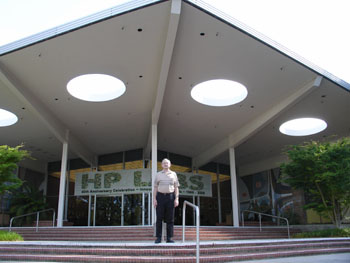 |
Kenneth Kuhn standing at the entrance of HP Labs |
HP Labs
Another important location in HP history.
HP Labs was formed in 1966 under the direction of Barney Oliver. Its original objective was fundamental research in the four major business sections: electronics, solid state physics, physical electronics, and medical and chemical electronics instruments research.
By late 1967, one year after its creation, HP Labs had 207 employees working on 75 different projects with 18% of HP's total R&D budget.
Hewlett and Packard formed the HP Labs to perform research on product lines and business sectors which were not covered by the many product divisions. It was their intention to launch new products such as the HP-35 hand calculator which didn't belong in any operating division of the time.
 |
Glenn Robb is showing the main entrance mosaic of the HP Labs |
HP Labs
On the right photo, Glenn Robb is showing the main entrance mosaic pattern... Any good RF engineer will appreciate this.
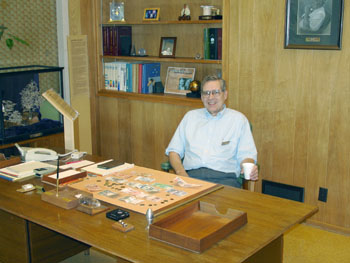 |
John Minck at Bill Hewlett's desk |
Bill and Dave's Office
Among the many HP historic VIPs that Ken and Glenn had the opportunity to meet during this silicon valley stay was John Minck who gave them a grand tour of the HP facilities. They included many valley locations such as the Cupertino computer complex, the Santa Clara Agilent complex, Trimble Road semiconductor operations and the Deer Creek location of the HP and Agilent R&D Laboratories, which are now closed.
John is sitting here at the Bill Hewlett's desk which is essentially unchanged since Bill retired.
John Minck is the author of "INSIDE HP: A narrative history of Hewlett-Packard from 1939-1990". This PDF document can be downloaded here.
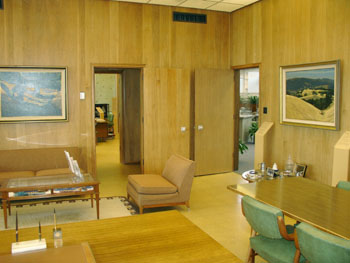 |
View from Packard's desk to Hewlett's desk |
Open Door Policy
Shown here is the evidence of Bill and Dave's "open door policy", one of the hallmarks of the 'HP Way', applied also for the two executives. They could even see each other when seated at their desks.
When one walks into those offices, one is transported back to the years of the 1960-80s, with the spartan office decorations simple indeed, plain floor tiles, an American flag in Packard's office from his national service as Deputy Secretary of Defense in the 1969-71 period. A remembrance photo on the wall shows the Premier of France, Charles DeGaulle, visiting HP.
 |
The HP Garden |
HP Executive Garden
Both Bill and Dave shared a view of a Japanese-style garden outside of their offices.
This picture was taken from inside Mr. Packard's office, whose desk is on the left.
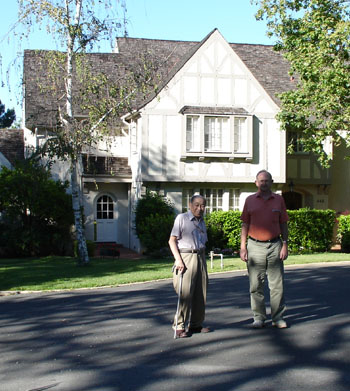 |
Art Fong (left) and Ken standing in front of the Fred Terman house |
Fred Terman's House
Another important location to both the Silicon Valley and Hewlett Packard history. Fred Terman was the professor and mentor of Bill Hewlett and Dave Packard at Stanford University. He is the man who urged the duo to start their own business in 1939.
Standing in front of Fred Terman's House, at the right of Ken is Mr. Art Fong. Art Fong was a Berkeley graduate who went to the MIT Radiation Laboratory in 1942 for research during WWII, and joined HP in 1946. Art was the lead designer for such a quantity of microwave instruments that he became known as "Mr. Microwave" at HP.
Among the many instrument projects that Art Fong had managed, the HP 8551A, first calibrated spectrum analyzer, is the most popular that can be listed.
John Minck estimates in his "INSIDE HP" narrative :
"At one time, we, in Microwave Marketing had added up the estimated revenues of all the popular instrument projects that Art had managed. It came out to more than $200 million dollars. I think our calculation was made in 1980. This included the HP 8551A, 606A, 618A, 623A, 803A/417A, 614A and many others. An unusually-productive career."
